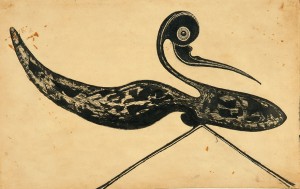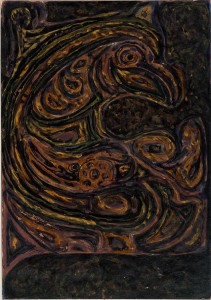Home / The Beginning
The Beginning
As a child, Rabindranath received brief lessons in drawing, but he found a stronger calling from poetry and literature. His practice of art did not extend beyond informal, imaginative doodles on the margins of his manuscripts. In his later years from around 1924, this unintended training in art spawned independent images to which he began to devote more and more time.

Untitled (Striding bird), 1928
Ink on paper
8 5/8 x 13 5/8 in. (21.9 x 34.6 cm)
Rabindra Bhavana, 00-2208-16
Tagore’s playful inventiveness transformed what were essentially marks of editorial errors and erasure into rhythmic lines and arabesques that seem to dance like imaginary creatures.
At the same time, cross-cultural encounters during his many foreign trips fed into his art. The revered Indian painter and art historian, K. G. Subramanyan, detects in Tagore’s work “motifs reminiscent of the primitive arts of the Pacific northwest or the islands of Melanesia or Micronesia . . . features that recall the decoration on totem poles, Chinese bronze vessels, primitive sculpture or various kinds of Art Nouveau artifacts. . . .”1

Untitled (Beaked zoomorphic form), c. 1931-32
Colored ink and poster paint on paper
14 13/16 x 10 7/16 in. (37.7 x 26.5 cm)
Rabindra Bhavana, 00-2231-16
In Tagore’s philosophy of art, cross-cultural influences as well as respect for arts of the past are essential for creativity and imagination, and they are the key to overcoming what he called the “insular modernism” that fails to harvest from the past.
1. K. G. Subramanyan, “Tagore: The Poet Painter and the West,” from Rabindranath Tagore: Collection of Essays, Ratan Parimoo, ed. (New Delhi: Lalit Kala Akademi, 1989), p. 17.

